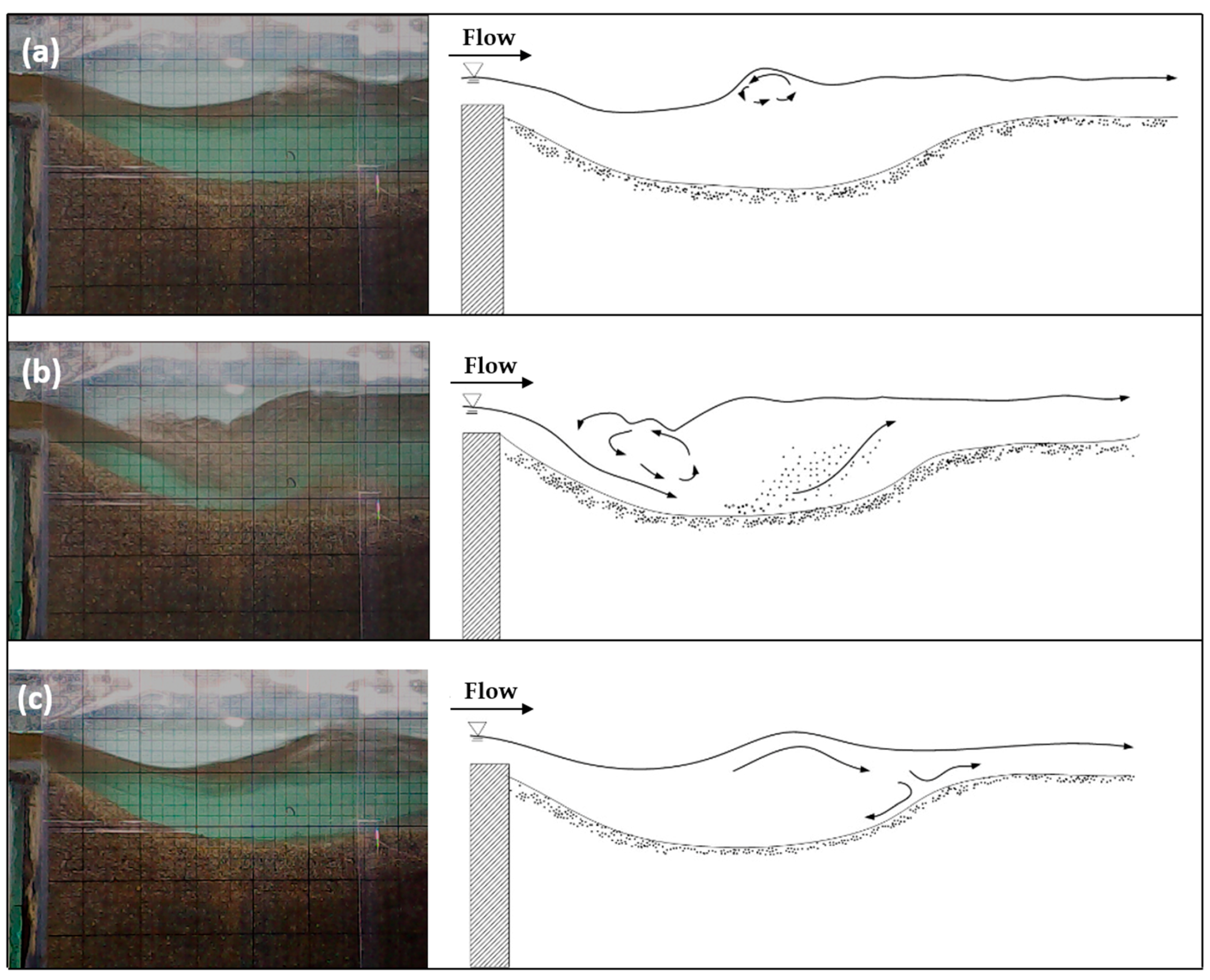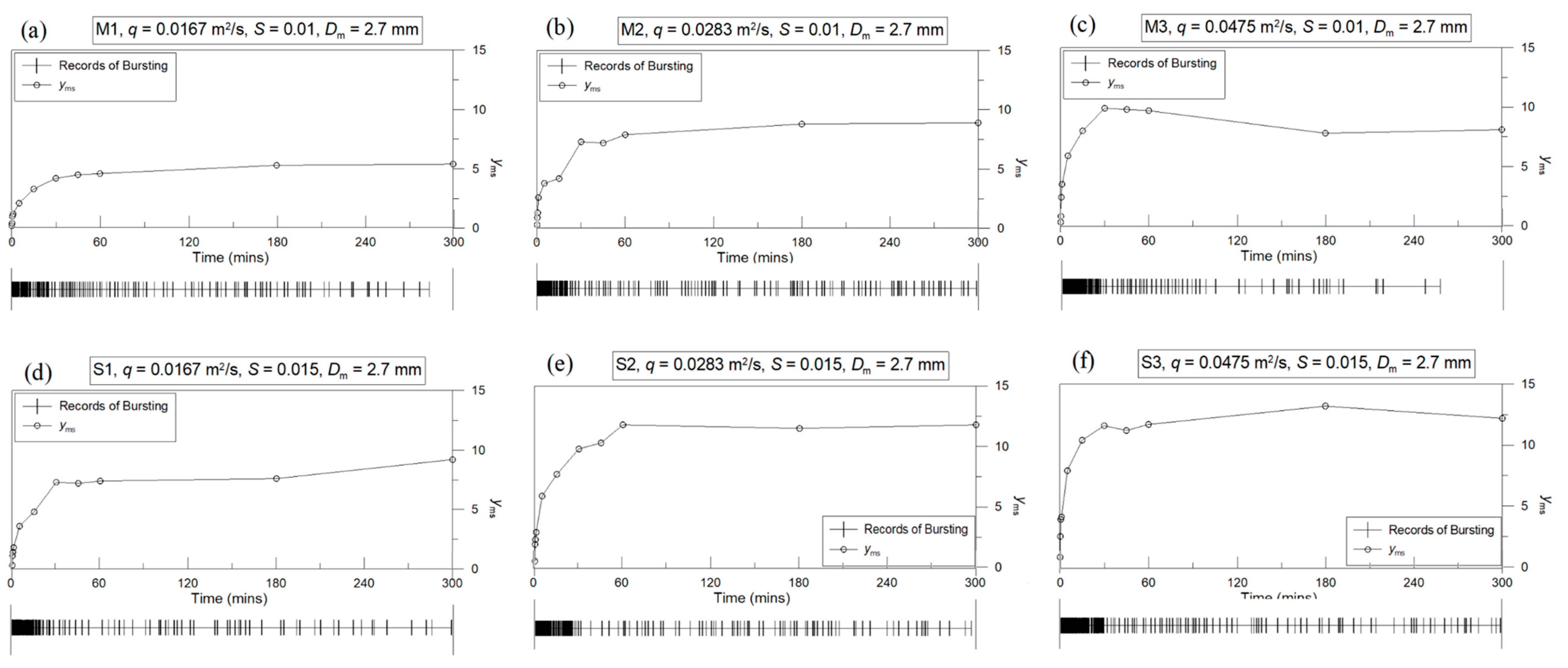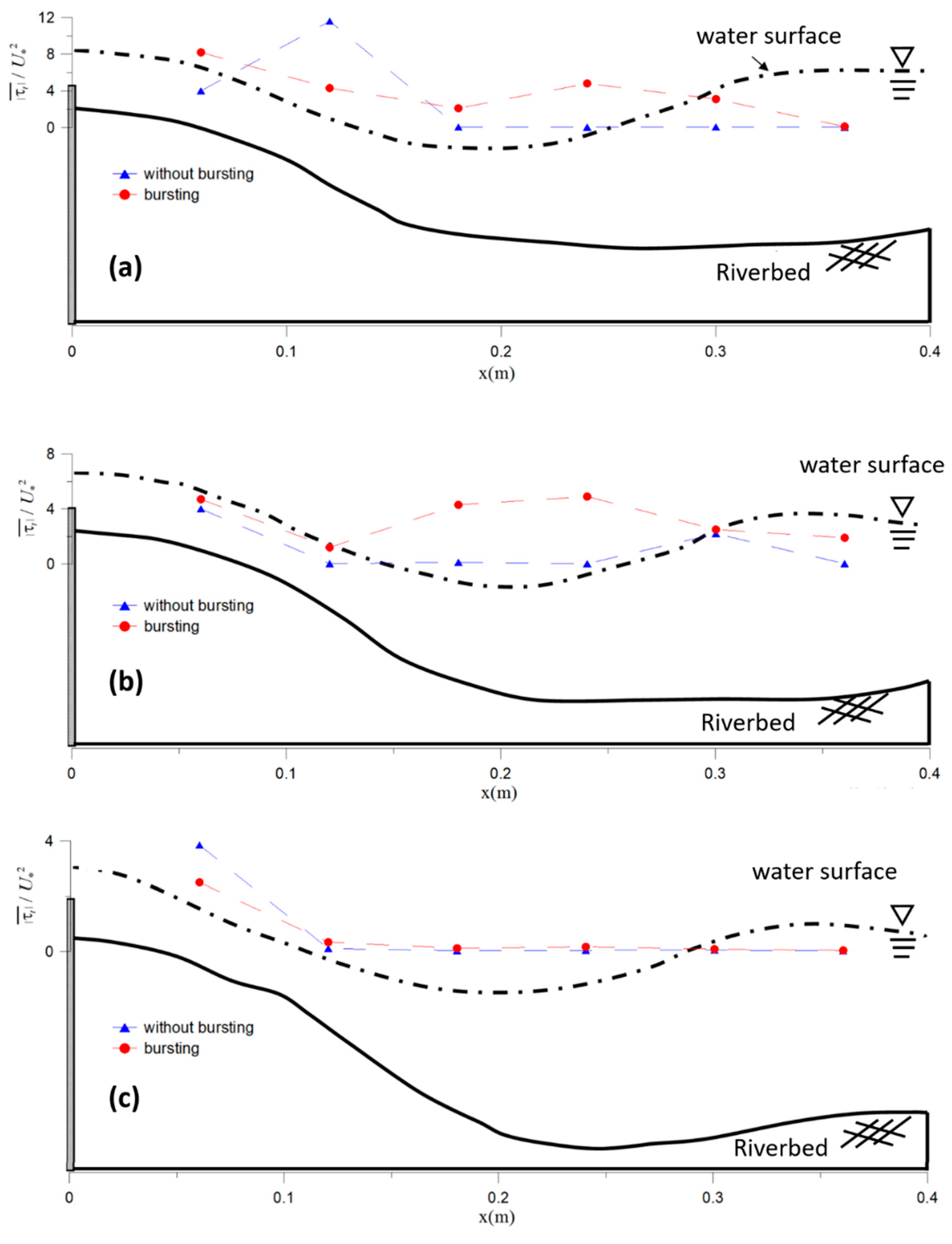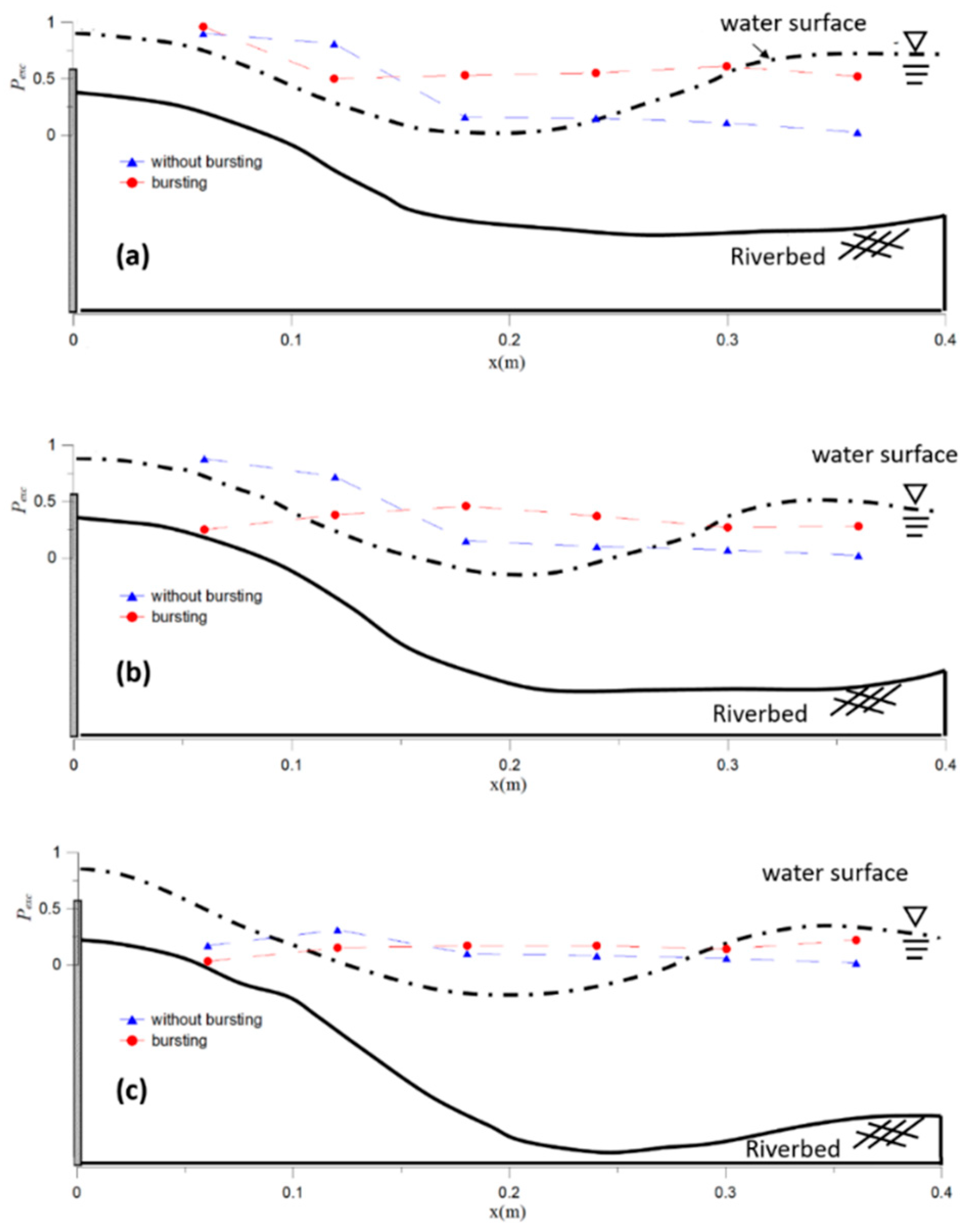Using a PIV Measurement System to Study the Occurrence of Bursting in the Flow Over a Movable Scour Hole Downstream of a Groundsill
Abstract
:1. Introduction
2. Experimental Setup
3. Results and Discussion
3.1. The Phenomenon of Bursting and It’s Occurrence Frequency
3.2. Analysis of the Characteristics of Bursting on the Flow Fields
3.3. Discussion of the Experimental Results with Scouring Exceedance Probability
4. Conclusions
Author Contributions
Funding
Conflicts of Interest
References
- Cao, Z. Turbulent bursting-based sediment entrainment function. J. Hydraul. Eng. 1997, 123, 233–236. [Google Scholar] [CrossRef]
- Liang, B.; Du, S.; Pan, X.; Zhang, L. Local scour for vertical piles in steady currents: Review of mechanisms, influencing factors and empirical equations. J. Mar. Sci. Eng. 2019, 8, 4. [Google Scholar] [CrossRef] [Green Version]
- Sechet, P.; Le Guennec, B. Bursting phenomenon and incipient motion of solid particles in bed-load transport. J. Hydraul. Res. 1999, 37, 683–696. [Google Scholar] [CrossRef]
- Nasrollahi, A.; Ghodsian, M.; Neyshabouri, S.S. Local scour at permeable spur dikes. J. Appl. Sci. 2008, 8, 3398–3406. [Google Scholar] [CrossRef] [Green Version]
- Mazumder, B.S.; Pal, D.K.; Ghoshal, K.; Ojha, S. Turbulence statistics of flow over isolated scalene and isosceles triangular-shaped bedforms. J. Hydraul. Res. 2009, 47, 626–637. [Google Scholar] [CrossRef]
- Keshavarzi, A.; Melville, B.; Ball, J. Three-dimensional analysis of coherent turbulent flow structure around a single circular bridge pier. Environ. Fluid Mech. 2014, 14, 821–847. [Google Scholar] [CrossRef]
- Pizarro, A.; Manfreda, S.; Tubaldi, E. The science behind scour at bridge foundations: A review. Water 2020, 12, 374. [Google Scholar] [CrossRef] [Green Version]
- Bernd, E.; Franciska, O.; Oscar, L. Live-bed scour at bridge piers in a lightweight polystyrene bed. J. Hydraul. Eng. 2015, 141. [Google Scholar] [CrossRef]
- Breusers, H.N.C. Proc. Symposium on model and prototype conformity: 1–8. In Conformity and Time Scale in Two-Dimensional Local Scour; Hydraulic Research Laboratory: Poona, India, 1966. [Google Scholar]
- Dietz, J.W. Scouring in fine or lightweight bed materials by subcritical flow. In Mitteilungen der Versuchsanstalt für Wasserbau und Kulturtechnik; Theodor-Rehbock-Flußbaulaboratorium, Universität Karlsruhe: Karlsruhe, Germany, 1969; pp. 1–120. (In German) [Google Scholar]
- Zanke, U. Zusammenhange Zwischen Stromung und Sedimenttransport; Des Franzius Instituts der Univ.: Hannover, Germany, 1978. (In German) [Google Scholar]
- Breusers, H.N.C.; Raudkivi, A.J. Scouring: Hydraulic Structures Design Manual; Balkema Publication: Rotterdam, The Netherlands, 1991. [Google Scholar]
- Adamo, F.; Andria, G.; Bottiglieri, O.; Cotecchia, F.; Di Nisio, A.; Miccoli, D.; Sollecito, F.; Spadavecchia, M.; Todaro, F.; Trotta, A.; et al. GeoLab, a measurement system for the geotechnical characterization of polluted submarine sediments. Measurement 2018, 127, 335–347. [Google Scholar] [CrossRef]
- Farhoudi, J.; Smith, K.V.H. Local scour profiles downstream of hydraulic jump. J. Hydraul. Res. 1985, 23, 343–358. [Google Scholar] [CrossRef]
- Oliveto, G.; Comuniello, V.; Onorati, B. Temporal development of local scour downstream of positive-step stilling basins. River flow 2008, 2, 1673–1678. [Google Scholar]
- Gaudio, R.; Marion, A.; Bovolin, V. Morphological effects of bed sills in degrading rivers. J. Hydraul. Res. 2000, 38, 89–96. [Google Scholar] [CrossRef]
- Gaudio, R.; Marion, A. Time evolution of scouring downstream of bed sills. J. Hydraul. Res. 2003, 41, 271–284. [Google Scholar] [CrossRef]
- Lu, S.Y.; Lu, J.Y.; Shih, D.S. Temporal and spatial flow variations over a movable scour hole downstream of a grade-control structure with a PIV system. Water 2018, 10, 1002. [Google Scholar] [CrossRef] [Green Version]
- Nezu, I.; Rodi, W. Open-channel flow measurements with a laser doppler anemometer. J. Hydraul. Eng. 1986, 112, 335–355. [Google Scholar] [CrossRef]
- Pagliara, S. Influence of sediment gradation on scour downstream of block ramps. J. Hydraul. Eng. 2007, 133, 1241–1248. [Google Scholar] [CrossRef]
- Lu, J.Y.; Hong, J.H.; Chang, K.P.; Lu, T.F. Evolution of scouring process downstream of grade-control structures under steady and unsteady flows. Hydrol. Process. 2012, 27, 2699–2709. [Google Scholar] [CrossRef]
- Shields, A. Anwendung der Ahnlichkeitsmechanik und Turbulenz Forschung Auf Die Geschiebebewegung; Mitteil. Preuss, Versuchsanst, Wasser, Erd; Schiffsbau: Berlin, Germany, 1936. [Google Scholar]
- Melville, B.W.; Coleman, S.E. Bridge. Scour; Water Resources Publications, LLC: Lone Tree, CO, USA, 2000; pp. 193–196. [Google Scholar]
- Bennett, S.; Alonso, C.V. Turbulent flow and bed pressure within headcut scour holes due to plane reattached jets. J. Hydraul. Res. 2006, 44, 510–521. [Google Scholar] [CrossRef]
- Rak, G.; Hočevar, M.; Steinman, F. Non-intrusive measurements of free-water-surface profiles and fluctuations of turbulent, two-phase flow using 2-D laser scanner. Meas. Sci. Technol. 2020, 31. [Google Scholar] [CrossRef]
- Dodaro, G.; Tafarojnoruz, A.; Calomino, F.; Gaudio, R.; Stefanucci, F.; Adduce, C.; Sciortino, G. An experimental and numerical study on the spatial and temporal evolution of a scour hole downstream of a rigid bed. In River Flow 2014; Informa UK Limited: London, UK, 2014; pp. 1415–1422. [Google Scholar]
- Guan, D.; Melville, B.; Friedrich, H. Local scour at submerged weirs in sand-bed channels. J. Hydraul. Res. 2016, 54, 1–13. [Google Scholar] [CrossRef]
- Wang, L.; Melville, B.; Guan, D. Effects of upstream weir slope on local scour at submerged weirs. J. Hydraul. Eng. 2018, 144. [Google Scholar] [CrossRef]
- Wang, L.; Melville, B.; Guan, D.; Whittaker, C. Local scour at downstream sloped submerged weirs. J. Hydraul. Eng. 2018, 144. [Google Scholar] [CrossRef]
- Shen, H.W.; Lu, J. Development and prediction of bed armoring. J. Hydraul. Eng. 1983, 109, 611–629. [Google Scholar] [CrossRef]
- Li, Y.; Wei, J.; Gao, X.; Chen, D.; Weng, S.; Du, W.; Wang, W.; Wang, J.; Tang, C.; Zhang, S. Turbulent bursting and sediment resuspension in hyper-eutrophic Lake Taihu, China. J. Hydrol. 2018, 565, 581–588. [Google Scholar] [CrossRef]
- Powell, D.M. Flow resistance in gravel-bed rivers: Progress in research. Earth-Sci. Rev. 2014, 136, 301–338. [Google Scholar] [CrossRef]
- Bathurst, J.C.; Li, R.M.; Simons, D.B. Resistance equation for large-scale roughness. J. Hydraul. Div. 1981, 107, 1593–1613. [Google Scholar]
- Lawrence, D.S.L. Macroscale surface roughness and frictional resistance in overland flow. Earth Surf. Proc. Land 1997, 22, 365–382. [Google Scholar] [CrossRef]
- Wu, S.; Rajaratnam, N. Submerged flow regimes of rectangular sharp-crested weirs. J. Hydraul. Eng. 1996, 122, 412–414. [Google Scholar] [CrossRef]








| Case | S (%) | H (m) | q (m2/s) | U (m/s) | (m/s) | Fr | Re | B/h |
|---|---|---|---|---|---|---|---|---|
| M1 | 1.0 | 0.017 | 0.0167 | 0.98 | 0.0397 | 2.41 | 15757 | 35 |
| M2 | 1.0 | 0.025 | 0.0283 | 1.13 | 0.0476 | 2.29 | 26045 | 24 |
| M3 | 1.0 | 0.034 | 0.0475 | 1.40 | 0.0547 | 2.42 | 45533 | 18 |
| S1 | 1.5 | 0.016 | 0.0167 | 1.04 | 0.0473 | 2.63 | 17327 | 38 |
| S2 | 1.5 | 0.023 | 0.0283 | 1.23 | 0.0561 | 2.59 | 26206 | 26 |
| S3 | 1.5 | 0.030 | 0.0475 | 1.58 | 0.0634 | 2.92 | 43053 | 20 |
| M1 | M2 | M3 | S1 | S2 | S3 | |
|---|---|---|---|---|---|---|
| Scouring exceedance probability with bursting | 53% | 52% | 43% | 35% | 47% | 47% |
| Scouring exceedance probability without bursting | 11% | 13% | 27% | 18% | 19% | 32% |
© 2020 by the authors. Licensee MDPI, Basel, Switzerland. This article is an open access article distributed under the terms and conditions of the Creative Commons Attribution (CC BY) license (http://creativecommons.org/licenses/by/4.0/).
Share and Cite
Chang, C.-K.; Lu, J.-Y.; Lu, S.-Y.; Hsiao, K.-T.; Shih, D.-S. Using a PIV Measurement System to Study the Occurrence of Bursting in the Flow Over a Movable Scour Hole Downstream of a Groundsill. Water 2020, 12, 1396. https://doi.org/10.3390/w12051396
Chang C-K, Lu J-Y, Lu S-Y, Hsiao K-T, Shih D-S. Using a PIV Measurement System to Study the Occurrence of Bursting in the Flow Over a Movable Scour Hole Downstream of a Groundsill. Water. 2020; 12(5):1396. https://doi.org/10.3390/w12051396
Chicago/Turabian StyleChang, Cheng-Kai, Jau-Yau Lu, Shi-Yan Lu, Kuo-Ting Hsiao, and Dong-Sin Shih. 2020. "Using a PIV Measurement System to Study the Occurrence of Bursting in the Flow Over a Movable Scour Hole Downstream of a Groundsill" Water 12, no. 5: 1396. https://doi.org/10.3390/w12051396
APA StyleChang, C.-K., Lu, J.-Y., Lu, S.-Y., Hsiao, K.-T., & Shih, D.-S. (2020). Using a PIV Measurement System to Study the Occurrence of Bursting in the Flow Over a Movable Scour Hole Downstream of a Groundsill. Water, 12(5), 1396. https://doi.org/10.3390/w12051396






